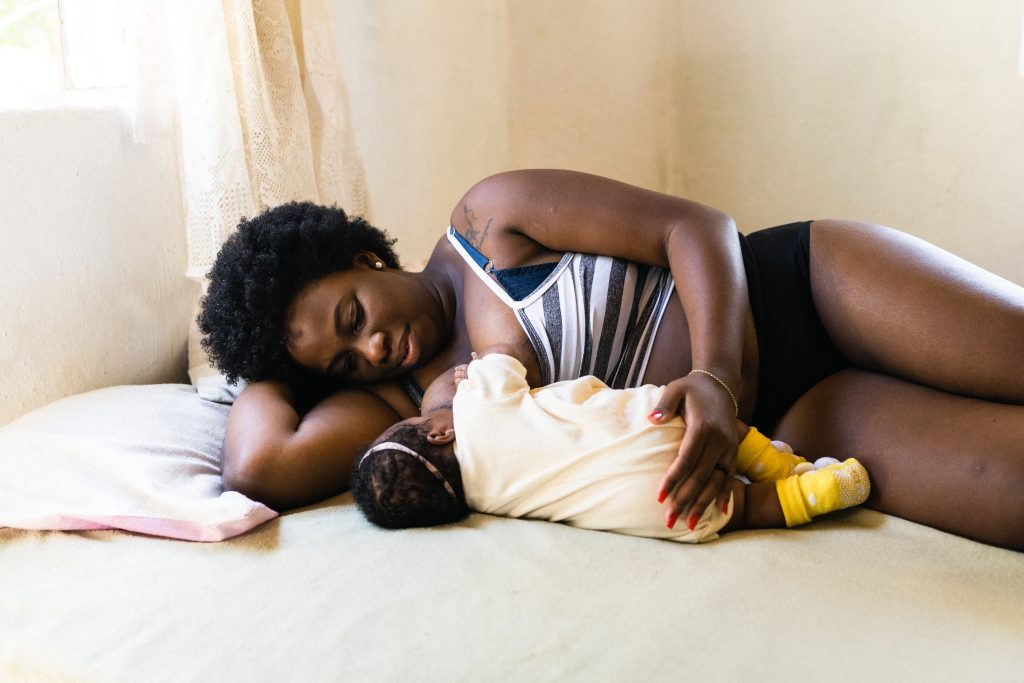Breastfeeding can be one of the most enjoyable experiences someone shares with their baby. It can feel natural and intuitive, or sometimes challenging or awkward. Part of breastfeeding is learning new physical skills for positioning and effective latching.
You will learn about nine different breastfeeding positions, some lying down and some sitting upright, some simple, and others a little more complex. Learn about different breastfeeding positions to make nursing comfortable and enjoyable for you and your baby. From cradle to football hold, find your perfect fit.

Find lactation consultants through The Mother Baby Center to support and empower you as you begin breastfeeding.
Preparing to breastfeed
Breastfeeding is a skill you learn “on the job.” You can read about breastfeeding while you are pregnant, but you don’t get to practice until your baby arrives. It is common for positioning and latches to feel awkward – it’s new to both you and baby. But that’s why we’re here to help!
One way to help is preparing to breastfeed – get comfortable, wear comfortable clothes, and have your gear nearby! Getting yourself prepared to breastfeed is just as important as getting your baby ready to breastfeed.
Get comfortable
Pick several places in your home that you would enjoy spending time in during feeding. Perhaps there is a window with a view or access to video or music for relaxation. If you will be sitting up, you’ll want a comfy chair, maybe one that rocks or has a footrest. Make sure your sitting, laying, or upright position is comfortable enough that you can stay in it for the length of your baby’s feed.
If you are not at home, another way to get comfortable is by surrounding yourself with an encouraging, kind, supportive group of family and friends, along with your partner. They can be there to help you feel comfortable breastfeeding in a different location than your usual space at home.
Get comfortable clothing and gear
Before breastfeeding, make sure you have everything you need nearby. You’ll want to wear a shirt or gown that can open up or slide off easily if you’re clothed. Gather some extra bedding and throw pillows to support your body and baby.
You can also invest in a breastfeeding pillow, also known as a nursing support to help you be more comfortable. If you are able, borrow several so you can try them out before investing in one of your own. It is also helpful to have a burp cloth for any spit-ups.
Another tip would be to have water and snacks for you! Staying hydrated is important for your recovery from birth, as well as for making milk. Having nutritious snacks handy is a great way to get in some extra calories during your busy days.

Learn about the many benefits of kangaroo care for physical and emotional health between you and your baby.
Breastfeeding positions to try
Breastfeeding is a learning process. Expect it to take time to feel natural and comfortable. That’s why learning about different breastfeeding holds for newborns will help. You’ll be able to try and experiment with different positions and see which ones work best for you both. Sometimes your little one will prefer one position at one feeding and another the next.
Here are a variety of breastfeeding positions to try. Some work well with most babies. Others are special positions that work best in certain situations.
The most commonly used newborn breastfeeding positions:
Slightly older babies are often ready to try these positions:
Other positions for specific situations:
- Double football hold: twin babies often feed well in this.
- Dancer hand position: Babies who are premature or have low muscle tone can benefit from this.
- Dangle feeding position: Mothers sometimes use this to help relieve plugged ducts.

Ensure your child’s health with a caring, and experienced physician, and find a provider today.
Laid back or reclined position
The laid-back or reclined position allows you to breastfeed in bed, a chair, or the couch. To use this position, you want to get in a comfortable reclined position and take off your shirt or nursing bra. You will want to have pillows to support your back, arms, and neck. Place your baby’s stomach on your stomach so its head is near your breast.
Gravity will help keep your baby in place in this position. They may naturally find your nipple on their own, or you may have to help them. This is a perfect newborn feeding position because it encourages the biological response for feeding when they are near your nipple.
Cross-cradle hold
The cross-cradle hold (also known as modified cradle hold) is a cradling position that helps give you a visual of your baby’s face while they feed and provides extra head and neck support. In this position, you will also want a pillow underneath the arm that is holding the baby.
In the cross-cradle hold breastfeeding position the baby will be in a similar position as the cradle hold but their head will be opposite. So, if you’re feeding your baby from your right breast (just like the example in the cradle hold description), you will hold their head in your left hand. Their body will lay on your left forearm and their butt will lay on your left elbow.
Football hold
The football breastfeeding position is a hold that is good for newborns as you can see their face. It’s also good for watching them as they nurse to see if they’re having any issues sucking or latching.
To get in the football hold breastfeeding position for your right breast, you will hold your baby’s head in your right hand and have their body/torso at your side, with baby’s feet touching the back of the chair. Use your right hand to guide baby to your breast to nurse. The same will be true if you are using your left breast but use your left hand.
Side lying position

Find out how long you should breastfeed and how to decide when the time is right for your family.
Many people wonder how to breastfeed lying down, and the side-lying position is the perfect position for that! This position is helpful for people who have had a Cesarean birth (C-section) as it could relieve some of their pain to lay down. This is just one of several options for breastfeeding positions lying down.
In this position, you will lie down on your side and lie your baby down on their side facing you. You will want their tummy by your tummy and their face at your breast. You’ll want to support your head with pillows or your arm.
Koala hold
The koala hold breastfeeding position is an upright breastfeeding position. Your baby will be resting on your thigh or hip and be facing you with their back and head upright. If you are using this breastfeeding position for a newborn, just make sure to give them enough support. If your child is old enough, they’ll be able to sit in this position without support.
This specific hold is a great breastfeeding position for a baby with reflux because your baby will stay upright while they feed rather than lying down. This position can also be the best feeding position for a baby with tongue tie.
Cradle hold

The cradle-hold breastfeeding position is probably the most classic position you think of when you think of nursing. This position works best when baby is a few weeks old and has a little more control of their head. This position is comfortable for both baby and parent, which is why it’s so common.
To do the cradle hold, you will be sitting upright on a couch, chair, or in bed. Putting a pillow beneath the arm that you will be holding your baby will help you be most comfortable. Also, putting pillows behind your back and neck will help too.
If you are feeding from your right breast, then you’ll place your baby’s head in your right elbow area (where your arm bends), their body will lay on your forearm against your stomach and you will hold their butt in your right hand. This will give them a little height and you can adjust your elbow height to get them in the right position for feeding.
Double football hold

The Mother Baby Center offers support from lactation consultants for every stage of your breastfeeding timeline.
The double football hold position is the same as the football hold but relevant if you are feeding twins. Then you would feed one twin on the right breast with their head in your right hand and you feed the other twin on your left breast with your left hand.
Dancer hold
The dancer-hand nursing position is a good position for newborns, especially those who may have been born prematurely or born with Down syndrome. These babies may not have low muscle tone and may struggle to latch on to your breast as you nurse. This position allows you to keep your baby’s head steady while they feed.
As you sit, you will gently cup and hold the underside of your breast with one hand – specifically with your four fingers under your breast and your thumb on top. You will then slide your hand forward and make a “U” shape with your thumb and index finger and your other three fingers will stay under your breast. With the “U” shape, you’ll use your index finger to hold one side of your baby’s cheek, your thumb will hold the other and their chin will rest in the middle.
Dangle feeding
The dangle feeding position may be a good position to try when you feel like your milk ducts are getting plugged. Gravity may help the situation. In order for you to get in the dangle feeding position, you will place your baby laying down on their back. You will get on your hands and knees and position your breast so it dangles in line with your baby’s face bringing your nipple to their mouth. You can also try this feeding position kneeling over them or almost laying down but propped up on pillows or your arm.

Learn how The Mother Baby Center provides childbirth recovery support and care.
Tips for a good latch
A latch is when your baby’s mouth attaches to your breast and baby begins to suck effectively. The baby is latched well when their suck feels like strong tugging and does not cause a lot of pain. There are a few ways to ensure your baby has a good latch.
- Skin-to-skin: In the first few days, unwrapping/undressing your baby and putting baby on your bare skin will make it easier for your baby to find your breast and latch on.
- Follow your baby’s lead: Babies latch best when they actively reach toward your breast. So, let your baby lead the latch – follow their cues. If your baby is crying and can’t latch, take a break to reset. When your baby shows cues (hand to mouth, turning toward your breast),
- Strive for good positioning: Because your baby has been curled up in the womb, they will need to uncurl and reach up to your breast in order to feed. Here’s some advice for good positioning:
- Position your baby’s nose or upper lip close to your nipple, in a sniffing position.
- Wait for your baby to move in (or burrow) toward your nipple.
- Then, gently support and lift baby’s head as baby latches.
- Look for baby’s nose, cheeks, and chin to gently touch your breast.
- Your baby’s chin should not be tucked down. It is easier for baby to breathe and swallow if your baby’s chin is lifted off their chest.
- Create a calm environment: Make sure the environment around you is comfortable for both you and baby while trying to latch.
When to see a lactation specialist
While research shows the positive benefits of breastfeeding, it is a learning process. Our entire mother and baby nursing staff and medical providers, as well as our lactation consultants, offer support to families and babies learning how to breastfeed. If you need extra support, you may request to see a consultant during your stay at The Mother Baby Center or make an appointment after you leave.
Our labor and delivery and postpartum nurses, as well as our lactation consultants, can help you address questions and concerns about so much, like breastfeeding/chestfeeding positions, strategies for the best latch, and how to know if baby is getting enough. Even when breastfeeding gets off to a great start, so much changes in the first few weeks. Reach out and ask – our consultants love to listen and teach.

Learn how you can find additional support through milk donations and milk banks with The Mother Baby Center.
What is milk donation?
For various reasons, a parent may not always be able to produce breast milk for their baby—milk banks offer another way for baby to receive human milk. Second only to a mother’s own breast milk, donated milk is a wonderful way for babies to receive the very best nutrition.
Donor milk is often used as a bridge to help nourish premature babies until a birth parent’s milk comes in and for other babies with special needs. If you are interested in donating your milk, you can register with the Minnesota Milk Bank for Babies. Once you are a registered donor, you can drop off your breast milk at one of The Mother Baby Center Milk Depots!
Learn how you can find additional support through milk donations and milk banks with The Mother Baby Center.
Benefits of breastfeeding
The list of benefits of breastfeeding is long – and there are benefits for both parent and baby! The most obvious one is the simple connection both baby and parent feel while breastfeeding (especially when done skin-to-skin!). It’s a moment in time spent with the two people connected together – a parent providing for their child, and a child being fed by their parent.
But there are more benefits than just the emotional connection. Breast milk can pass on many antibodies and nutrients to help your baby stay healthy and grow strong. Read on to learn the different benefits of breastfeeding for babies and parents.
Why breastfeeding is great for skin-to-skin contact
Skin-to-skin contact is when you hold your naked (or diapered) baby to your bare skin/chest. Breastfeeding is just one way to accomplish skin-to-skin contact, but it is an amazing way to do so! Holding your baby skin-to-skin will allow them to get to know you through your scent, your touch, your voice, and the feel of your skin.
Breastfeeding is a great time to have skin-to-skin contact with your baby because you can hold them close, talk to them and soothe them. It’s a great bonding moment! Having skin-to-skin contact can also actually encourage your body to make more milk.
Benefits for the baby
There are many benefits of breastfeeding for you but also for the baby! One of the best benefits is the simple, yet important, health benefits breastfeeding provides for your little one.
- Breast milk has all of the nutrients a newborn needs to grow big and strong.
- It has antibodies that help protect babies from many infections, including diarrhea and ear and lung infections.
- Breastfed babies are less likely to develop medical problems such as obesity, diabetes, high cholesterol, asthma, allergies, and certain childhood cancers.

Meet other parents and find community through support groups from The Mother Baby Center.
Benefits for the parent
In addition to helping the baby, breastfeeding can help you as well. Overall, there are many benefits to breastfeeding for the parent if you are able to do so. Here are some of the benefits for the parent:
- Can be a way to bond with your child and enhance the emotional connection with your baby.
- Feel confident in your abilities to care for your child.
- Breastfeeding can be quicker and cost less.
- Longer-term breastfeeding decreases the lifetime risk of heart disease and estrogen-dependent types of breast cancer and ovarian cancer.
Benefits for the environment
We bet you didn’t guess that breastfeeding can even be beneficial for the environment! From reducing resources used to produce ingredients, packaging and distribution of breast milk substitutes like formula, breastfeeding can reduce packaging waste and save energy from the creation and distribution process.
The Mother Baby Center provides breastfeeding and lactation support and care for new parents
At the Mother Baby Center, we understand that not everyone’s breastfeeding journey is easy. Each person’s experience is unique. Some families need or choose to offer their babies pumped milk or formula in addition to breastfeeding. If you are struggling with your breastfeeding journey or simply want breastfeeding support, contact one of the breastfeeding clinics to see how we can best support you.
- Minneapolis: The Infant Feeding Center at Abbott Northwestern Hospital: 612-863-4638.
- St. Paul: The Breastfeeding Resource Center at United Hospital 651-241-6250.
- Coon Rapids: The Breastfeeding Clinic of Mercy Medical Center 763-236-7430.
If you feel like you might just need virtual breastfeeding support, we partner with the Nest Collaborative to provide just that! You can virtually meet with International Board-Certified Lactation Consultants® who will help guide parents through the breastfeeding process.